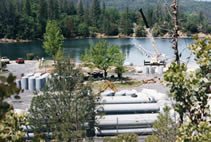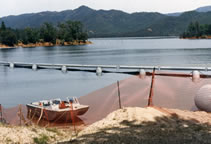Northern California's Sacramento River is one of this country's most beautiful waterways, and an important breeding site for the winter run Chinook salmon. It is also the site of an innovative program run by the U.S. Department of the Interior's Bureau of Reclamation designed to keep the salmon population healthy and growing.
The hardy salmon thrive in colder water, but suffer ill effects when water temperatures rise above 56 ° F. The Sacramento River is fed from two lakes whose waters are warmed by radiational heating-Lake Shasta and Whiskey-town Lake. The flow of warmer water into the river was causing egg mortality among the spawning salmon and, in some instances, killing the salmon. But how could the Bureau of Reclamation possibly keep the warm lake waters from commingling with the cooler Sacramento River?
Keeping Things Cool
This difficult situation required an innovative solution. The key was to contain the warmer surface waters from Whiskeytown Lake, while allowing the cooler water from the lake's depths to flow into the river. The Bureau of Reclamation designed a series of remarkable blocking devices-called Temperature Control Curtains-to deter the warm water from the lake's surface from reaching the Sacramento. Each Temperature Control Curtain consists of a series of metal booms and steel ballast buoys, supporting a fabric "curtain" that controls the flow of lake water down to a specified depth. Cooler water from deeper in the lake is allowed to flow freely under the curtain and into the river.
Keeping Rust at Bay
The constant submersion of the 85,500 square feet of steel that comprises the Temperature Control Curtains, combined with exposure to the elements, promotes the ideal breeding ground for rust and corrosion. Because of the importance of the project, minimizing downtime is critical. That's why all metal surfaces are coated with Z.R.C. Galvanizing Compound prior to assembly.
The Bureau of Reclamation's head engineer for the project, Greg O'Haver, wrote a zinc rich compound into the specifications when designing the extraordinary Temperature Control Curtains. Z.R.C. Galvanizing Compound was selected by the fabricator because of its record of successful performance even under the most extreme conditions.
Fabrication subcontractor RB Fab of Suisun, California sandblasted the surface to commercial profile (SSPC-SP6), then applied Z.R.C. by roller. "Z.R.C. is ideally suited to the types of materials we're using," stated Ron Goode of RB Fab. "Because of the ease of application, Z.R.C. works very well."
No topcoat was applied over the Z.R.C. This will facilitate future maintenance, as it eliminates the expensive and potentially environmentally damaging process of sandblasting several coats of epoxy when the time comes to recoat exposed surfaces.
The results have been outstanding. The curtain assemblies are in full operation with no sign of corrosion. This despite being in an environment of total immersion.
The ZRC Difference
Why does Z.R.C. perform so well under such conditions? Unlike other coatings, Z.R.C. is a 95% liquid zinc organic compound. The galvanic protection of zinc acts as a physical barrier against rust, rust creepage and contaminants. As the zinc content of Z.R.C. is sacrificed to prevent rust from starting, insoluble corrosion by-products are formed. These by-products fill voids and pores in the zinc primer film, forming an insoluble barrier to further protect against attacks on the zinc film and steel substrate. Many of these by-products also tend to inhibit the rusting process by increasing the pH level.
Z.R.C. continues to provide protection against rust and rust creepage even if the protected surface is scratched to the bare metal. The zinc forms a layer of insoluble zinc salt over the exposed area, "healing" the break and providing protection against corrosion. Due to these properties, Z.R.C. is often specified for applications in highly corrosive environments.
Happy Fish
The results of the Temperature Control Curtain project have been remarkable. The flow of warm water into the Sacramento River has been substantially reduced, thus supporting the migration and breeding cycle of the Chinook salmon.
Once again, Z.R.C. is playing a key role in keeping an important project free from rust and corrosion.




